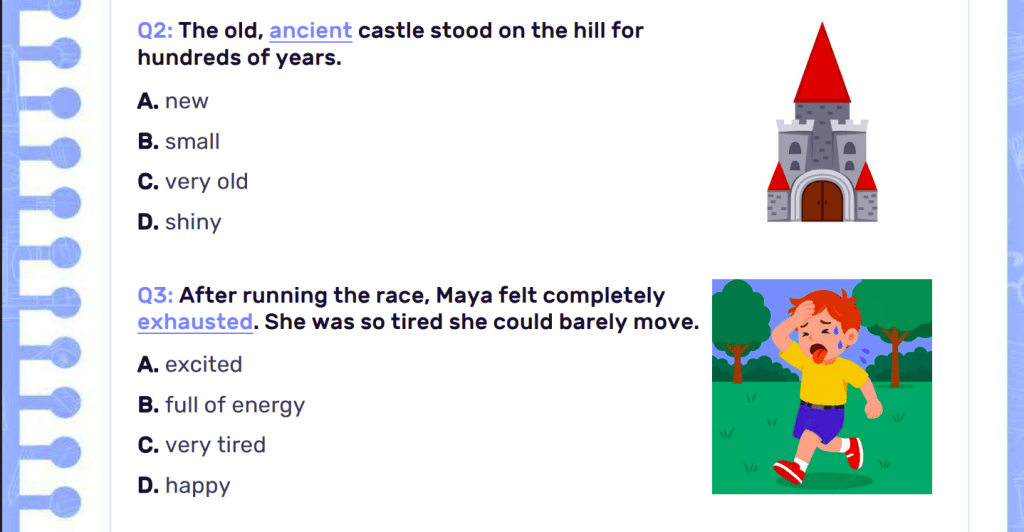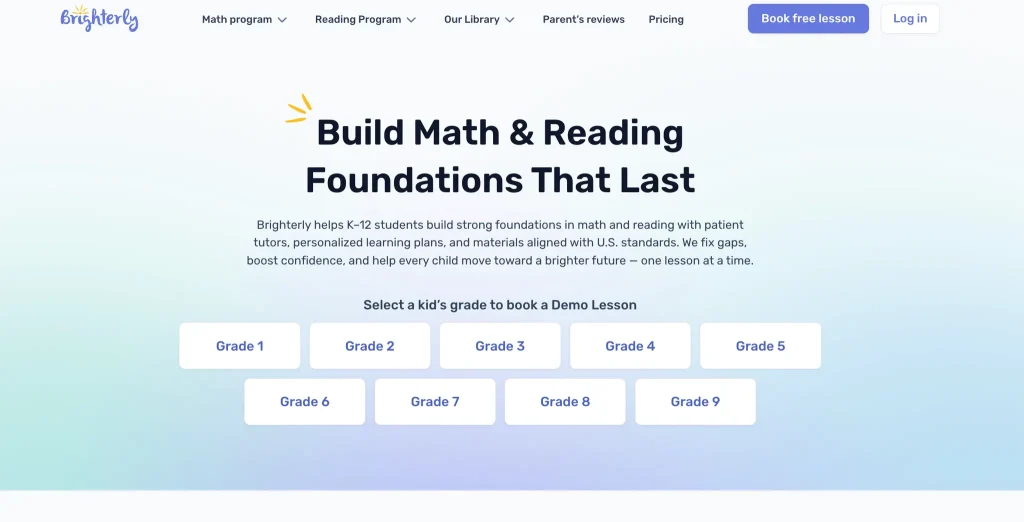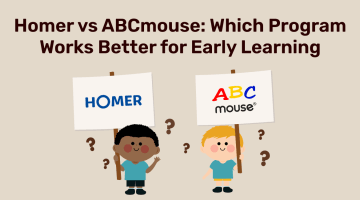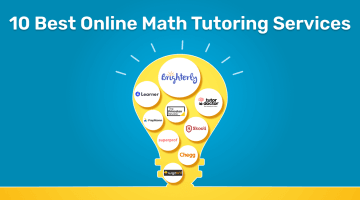How to Teach Context Clues to Your Child: Best Strategies
reviewed by Laila A. Lico
Updated on October 22, 2025
As a classroom teacher, I’ve watched hesitant readers transform once they learn how to use context clues. It’s like handing them a quiet superpower: suddenly, unfamiliar words stop being roadblocks and start being puzzles they can solve.
This guide will offer practical teaching context clues strategies, examples from the classroom, and printable material to support comprehension. So, are you ready to support your child’s confident reading?
Key points:
- Context clues help children understand new words by using hints from the surrounding text.
- Teaching context clues strategies can help to build fluency, vocabulary, and comprehension.
- Use a personalized Brighterly reading tutor to help with progression. This reliable math and reading platform will provide personalized feedback using engaging and exciting methods.
Why are context clues important in reading for kids
Context clues are important because they help children use nearby words, sentences, and text features to figure out the unfamiliar vocabulary based on context clues meaning, without stopping every minute to ask an adult or look it up in the dictionary.
This fosters independence, fluency, and comprehension, especially when texts include context clues vocabulary beyond the kids’ current level.
Common types of context clues kids should know
| Definition | The word is defined in the sentence. | A botanist — a scientist who studies plants — observed the seedling. |
| Synonym/Restatement | A similar word or phrase appears nearby. |
The trail was treacherous, dangerous after the rain. |
| Antonym/Contrast | An opposite clue indicating what the word could mean. | Unlike his timid cat, my dog is bold. |
| Example | Examples illustrate the meaning. |
Arthropods (spiders, ants, beetles) are insects with exoskeletons. |
| Inference/Generalization | Readers combine hints and clues to infer meaning. | She hoarded snacks; her drawers bulged with unopened packs. |
| Punctuation/Signal words | Dash, commas, “that is,” “or,” “in other words.” | Arboreal animals — that is, creatures that live in trees — include monkeys and sloths. |
| Morphology supports context | Roots/affixes + sentence clues | Subterranean cave → sub (under) + context (cave) → under the ground. |
Examples of context clues to teach your child
Now that you know what are context clues, it’s the right time to start introducing them to your child. For example, you can ask them to find synonyms in the text you read or use definitions to explain complex words (like saying “it’s a tall building” for a “skyscraper”).
That said, below you can find an exact examples of how you can implement the context clues practice:
|
When a 3rd grader first meets the word “reluctant,” you can first read aloud the whole sentence: “I was reluctant to join the race; my legs felt heavy, and the sky darkened.” You can ask the question, “What clues show how the character felt?” to boost the analysis. The child will notice that the character’s “legs felt heavy” and “the sky darkened.” Those phrases hint that they didn’t really want to join — that’s what “reluctant” means. |
What are the best context clues strategies for kids?
- Word detective routine (with worksheets)
- Small-group reading tutors for extra support
- Anchor Chart walk
- Contrast & connect
- Morphology helps meaning
- Partner explain & sketch
- Timed “find-the-clue” sprint
- Read-mark-explain with passage ladders
- Home link: family read-alouds

Context clues strategies for kids are simple techniques that help children determine the meaning of unfamiliar words by looking at the clues within a sentence or paragraph. By practicing these strategies, kids learn to read more independently, build a stronger vocabulary, and understand texts without constantly stopping to ask for help or use a dictionary. After learning clearly what are context clues in reading, let’s take a closer look at these strategies.
Practicing context clues for kids by using the word detective routine
Best for: Elementary readers who need repeated practice with context clues for kids & those who require context clues definition for kids explained simply.
Students learn best when they can practice context clues strategies on their own. That’s why this simple “Word Detective” routine works every time. Here are some of the most popular samples:
- Read the complete sentence (also one before/after).
- Identify the clue type (definition, synonym, antonym, example, inference).
- Think of a meaning that makes sense in the sentence.
- Underline the exact clues that helped you.
Example activity: Word detective routine with printable worksheets
For maximum effectiveness, I rotate difficulty for teaching context clues in 2nd grade, 3rd grade, 4th grade, and middle school, so each child gets just the right challenge.
You can find lots of relevant activities of this type in reading worksheets for kids, specifically developed by the Brighterly math and reading platform. What’s best, they feature grade-specific samples, like:
One strong pro point for using those worksheets is that they align with US schedules. Questions in them strongly resemble what you’ll find in your tests; that’s why they fit the test preparation needs perfectly.
Teaching context clues with small-group reading tutors for extra support
Best for: Readers who need targeted help using context clues and who benefit from immediate feedback.
While teaching context clues, a professional teacher can pair short read-alouds with think-alouds: they stop at an unknown word, underline clues, and guide students to determine the meaning. This format is powerful for struggling, ESL, and upper elementary learners.
That’s why a personalized approach matters — your child receives just the level of attention they need.
Why opt for Brighterly 1:1 tuition?
If your child needs tailored, structured sessions, explore reading tutors through the Brighterly math and reading platform.
Benefits of Brighterly
- Constant progress tracking & feedback for parents
After every session, parents receive clear updates on reading progress, strengths, and next steps. This transparent feedback loop keeps families involved and motivated while helping tutors adjust lessons for faster improvement.
- US-accepted school curriculum
All Brighterly reading and math lessons follow the curricula widely adopted in U.S. schools. This ensures every skill, from context clues strategies to comprehension, is taught in a way that supports classroom success.
- Affordable, flexible pricing
Brighterly reading program offers personalized 1-on-1 tutoring at prices lower than most local centers. Families can choose flexible plans that fit any schedule and budget, without sacrificing quality instruction or measurable results.
Using context clues strategies with an anchor chart walk
Best for: Visual learners who benefit from seeing patterns and examples during each lesson on context clues.
An anchor chart walk is a visual routine that helps students organize and remember context clues strategies. The teacher and students build the chart together throughout the week, adding new examples of definition, synonym, antonym, and inference clues as they appear in daily reading.
Example activity:
On Monday, you can draw a large chart with four columns:
- Type
- Signal words
- Example
- Student sentence
Let’s take the word “timid” for example:
The sentence here can be: “Unlike his confident brother, Leo felt timid during the show.”
Students underline “unlike his confident brother” and record it under the Antonym column as their clue. By Friday, the wall will be filled with colorful examples the class created together, each showing how to use context clues in real reading situations.
How to teach context clues through contrast and connect activities
Best for: Students who mix up antonyms and synonyms.

The contrast and connect approach is a hands-on way to practice using context clues to determine word meaning through opposites and similarities. This routine strengthens reasoning skills and deepens vocabulary understanding.
Example activity:
Write two sentences on the board:
“The path was treacherous; in other words, it was steep and unsafe.”
“Unlike the calm morning, the storm was fierce and noisy.”
Ask the kid to underline the signal words (“in other words”, “unlike”), label each as a synonym or antonym clue, and explain how the phrase helps them define “treacherous” and “fierce”.
Using morphology and context clues to determine word meaning
Best for: Grades 3–6+ & when kids frequently practice affixes.
This method blends morphology with context clues strategies to help children analyze how words work. Students first look inside a word to predict meaning, then check the sentence to confirm or refine it.
Example activity:
Create a “Word Detective Chart” with three columns:
- Word
- Morphology Guess
- Context Check
Write: “His misconduct at recess disappointed the teacher.”
Students might say misconduct = not conduct, but then read the sentence and realize misconduct must mean bad behavior.
Teaching context clues for vocabulary with partner, explain & sketch
Best for: Readers who learn through discussion, creativity, and collaboration.

This activity combines social learning with visual thinking. Working in pairs helps children explain their reasoning aloud, listen to others, and visualize how context clues for vocabulary reveal meaning.
Example activity:
Each pair chooses a challenging sentence, such as:
“After the marathon, Lila was completely depleted, unable to move another step.”
Together, they underline the clues (“after the marathon”, “unable to move”), agree that “depleted” means very tired, and draw a small sketch to illustrate it. On the back of the card, they write their own sentence using “depleted”.
How to use context clues with timed “find-the-clue” sprints
Best for: Building speed and confidence with context clues strategies.
This fast-paced game helps students spot context clues automatically. In one-minute rounds, they highlight signal words, underline clue phrases, and write a short context clues definition for kids. It’s ideal for teaching context clues 3rd grade and 4th grade, adding fun repetition that builds fluency and focus.
Example activity:
Use a short passage from a context clues activities in the PDF worksheets we discussed above.
- Round 1: highlight signal words like “because” or “unlike”.
- Round 2: underline the clue and write a quick definition.
After each sprint, compare answers and discuss clue types for a quick, energetic review.
Lesson on context clues: Read-mark-explain with passage ladders
Best for: Middle school and advanced elementary readers.
This lesson on context clues builds independence by encouraging students to read, mark the clues, and briefly explain how each clue helped them find meaning.
Example activity:
Give students three short passages: easy, medium, and challenging. After each, they underline one context clue, name its type, and write a one-sentence explanation.
Family read-alouds for teaching context clues at home
Best for: Any grade; builds shared language and confidence.

Family read-alouds make teaching context clues fun and personal. Here, parents and kids read together, pause at tricky words, and use nearby phrases to guess meanings.
Example activity:
During bedtime reading, stop at an unfamiliar word like “gloomy”.
Ask: “Which words help you figure it out?” (“dark sky”, “no one smiled”).
Have your child explain the clues and test the meaning in the sentence; it’s an easy daily way to build skills on context clues for kids.
What is the best way of helping struggling students use context clues?
To help struggling students use context clues, start with think-aloud modeling using short, high-interest passages. Then, add an anchor chart of the different types of clues. Remember to practice daily with nonsense words and real texts. Finally, combine morphology and context and provide independent practice via targeted worksheet sets.
Teaching context clues with these grade-by-grade notes for quick wins
- Teaching context clues 2nd grade: Keep to definition/synonym/example; partner sketch; very short sentences.
- How to teach context clues 3rd Grade: Add antonyms and nonsense words; introduce morphology lightly; laddered passages.
- Teaching context clues 4th grade: Mix inferences, context + morphology; require evidence sentences.
- Teaching context clues middle school: Multi-paragraph inference, tone, and contrast; cite different types and examples precisely.
Conclusion
Teaching students to use context clues is one of the most powerful habits we can give them. With this skill mastered, students will become proficient at determining meanings, maintaining comprehension, and keeping momentum through tricky texts with a few consistent strategies. If you are wondering how to teach context clues at home or school, start small with one routine, one chart, and 5 minutes a day.
And if your kid needs a boost, a supportive reading program can accelerate the process with lesson plans matched to their current level. You can book free reading lesson at Brighterly to see how their adaptive curricula work for your child.
















